
Grading in an Online Course
- Subject:
- Education
- Material Type:
- Activity/Lab
- Reading
- Provider:
- AEA Learning Online
- Provider Set:
- OLLIE
- Author:
- Evan Abbey
- Date Added:
- 01/13/2021

Grading in an Online Course
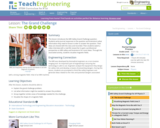
This lesson introduces the MRI Safety Grand Challenge question. Students are asked to write journal responses to the question and brainstorm what information they will need to answer the question. The ideas are shared with the class and recorded. Students then watch a video interview with a real life researcher to gain a professional perspective on MRI safety and brainstorm any additional ideas. The associated activity provides students the opportunity to visualize magnetic fields.
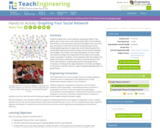
Students analyze their social networks using graph theory. They gather data on their own social relationships, either from Facebook interactions or the interactions they have throughout the course of a day, recording it in Microsoft Excel and using Cytoscape (a free, downloadable application) to generate social network graphs that visually illustrate the key persons (nodes) and connections between them (edges). The nodes in the Cytoscape graphs are color-coded and sized according to the importance of the node (in this activity, nodes are people in students' social networks). After the analysis, the graphs are further examined to see what can be learned from the visual representation. Students gain practice with graph theory vocabulary, including node, edge, betweeness centrality and degree on interaction, and learn about a range of engineering applications of graph theory.
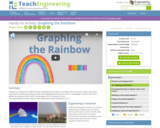
Students are introduced to different ways of displaying visual spectra, including colored "barcode" spectra, like those produced by a diffraction grating, and line plots displaying intensity versus color, or wavelength. Students learn that a diffraction grating acts like a prism, bending light into its component colors.

Students simulate disease transmission by collecting data based on their proximity to other students. One option for measuring proximity is by having Bluetooth devices "discover" each other. After data is collected, students apply graph theory to analyze it, and summarize their data and findings in lab report format. Students learn real-world engineering applications of graph theory and see how numerous instances of real-world relationships can be more thoroughly understood by applying graph theory. Also, by applying graph theory the students are able to come up with possible solutions to limit the spread of disease. The activity is intended to be part of a computer science curriculum and knowledge of the Java programming language is required. To complete the activity, a computer with Java installed and appropriate editing software is needed.
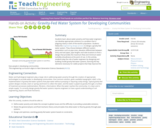
Students learn about water poverty and how water engineers can develop appropriate solutions to a problem that is plaguing nearly a sixth of the world's population. Students follow the engineering design process to design a gravity-fed water system. They choose between different system parameters such as pipe sizes, elevation differentials between entry and exit pipes, pipe lengths and tube locations to find a design that provides the maximum flow and minimum water turbidity (cloudiness) at the point of use. In this activity, students play the role of water engineers by designing and building model gravity-fed water systems, learning the key elements necessary for viable projects that help improve the lives people in developing communities.
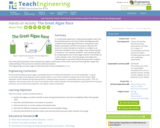
In a multi-week experiment, student groups gather data from the photobioreactors that they build to investigate growth conditions that make algae thrive best. Using plastic soda bottles, pond water and fish tank aerators, they vary the amount of carbon dioxide (or nutrients or sunlight, as an extension) available to the microalgae. They compare growth in aerated vs. non-aerated conditions. They measure growth by comparing the color of their algae cultures in the bottles to a color indicator scale. Then they graph and analyze the collected data to see which had the fastest growth. Students learn how plants biorecycle carbon dioxide into organic carbon (part of the carbon cycle) and how engineers apply their understanding of this process to maximize biofuel production.
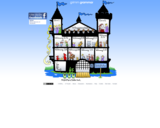
An online German grammar reference, featuring zany post-modern Grimm's fairy tale characters, authoritative grammar explanations, self-correcting exercises, online audio and cartoon images.

Grimm Grammar is an online German grammar reference from the University of Texas at Austin. It is an irreverent revival and shameless exploitation of 19th-century Grimm Fairy Tales for honorable pedagogical purposes.

The Group Dynamics of a School Project was developed in order for students to learn about group dynamics through acting out the roles of five diverse post secondary students trying to complete a group project. Key elements of group dynamics are portrayed including conflict, leadership skills, groupthink, group climate, microaggressions and more. Each scene contains a short script to be read out loud, a prompt for improvising an ending, discussion questions, and key takeaways. Students come away with a better understanding of the theories behind group dynamics, increased self awareness, and a better understanding of other group members.

Students discover how tiny microscopic plants can remove nutrients from polluted water. They also learn how to engineer a system to remove pollutants faster and faster by changing the environment for the algae.
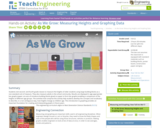
Students visit second- and fourth-grade classes to measure the heights of older students using large building blocks as a non-standard unit of measure. They also measure adults in the school community. Results are displayed in age-appropriate bar graphs (paper cut-outs of miniature building blocks glued on paper to form bar graphs) enabling a comparison of the heights of different age groups. The activities that comprise this activity help students develop the concepts and vocabulary to describe, in a non-ambiguous way, how heights change as children age. This introduction to graphing provides an important foundation for creating and interpreting graphs in future years.
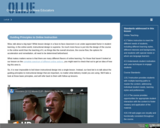
Guiding Principles to Online Instruction
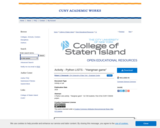
A Python Lists activity - "Hangman game" - for CS0 students. Part of the CUNY CS04All projec
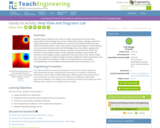
Students' eyes are opened to the value of creative, expressive and succinct visual presentation of data, findings and concepts. Student pairs design, redesign and perform simple experiments to test the differences in thermal conductivity (heat flow) through different media (foil and thin steel). Then students create visual diagrams of their findings that can be understood by anyone with little background on the subject, applying their newly learned art vocabulary and concepts to clearly communicate their results. The principles of visual design include contrast, alignment, repetition and proximity; the elements of visual design include an awareness of the use of lines, color, texture, shape, size, value and space. If students already have data available from other experiments, have them jump right into the diagram creation and critique portions of the activity.
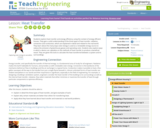
Students explore heat transfer and energy efficiency using the context of energy efficient houses. They gain a solid understanding of the three types of heat transfer: radiation, convection and conduction, which are explained in detail and related to the real world. They learn about the many ways solar energy is used as a renewable energy source to reduce the emission of greenhouse gasses and operating costs. Students also explore ways in which a device can capitalize on the methods of heat transfer to produce a beneficial result. They are given the tools to calculate the heat transferred between a system and its surroundings.
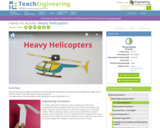
Students learn about weight and drag forces by making paper helicopters and measuring how adding more weight affects the time it takes for the helicopters to fall to the ground.
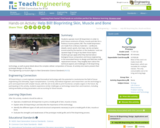
Students operate mock 3D bioprinters in order to print tissue constructs of bone, muscle and skin for a fictitious trauma patient, Bill. The model bioprinters are made from ordinary materials— cardboard, dowels, wood, spools, duct tape, zip ties and glue (constructed by the teacher or the students)—and use squeeze bags of icing to lay down tissue layers. Student groups apply what they learned about biological tissue composition and tissue engineering in the associated lesson to design and fabricate model replacement tissues. They tangibly learn about the technical aspects and challenges of 3D bioprinting technology, as well as great detail about the complex cellular composition of tissues. At activity end, teams present their prototype designs to the class.
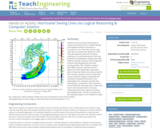
Students use a hurricane tracking map to measure the distance from a specific latitude and longitude location of the eye of a hurricane to a city. Then they use the map's scale factor to convert the distance to miles. They also apply the distance formula by creating an x-y coordinate plane on the map. Students are challenged to analyze what data might be used by computer science engineers to write code that generates hurricane tracking models. Then students analyze a MATLAB® computer code that uses the distance formula repetitively to generate a table of data that tracks a hurricane at specific time intervals. Students come to realize that using a computer program to generate the calculations (instead of by hand) is very advantageous for a dynamic situation like tracking storm movements. Their inspection of some MATLAB code helps them understand how it communicates what to do using mathematical formulas, logical instructions and repeated tasks. They also conclude that the example program is too simplistic to really be a useful tool; useful computer model tools must necessarily be much more complex.

If you have found yourself searching for, adapting or creating materials for your heritage classes because of a lack of readily available commercial resources, this site is for you!